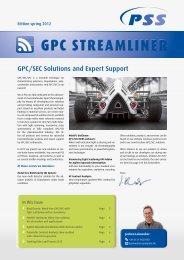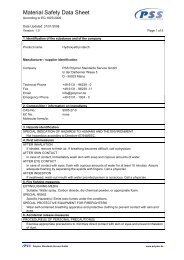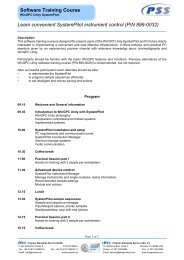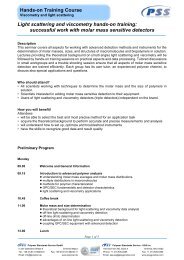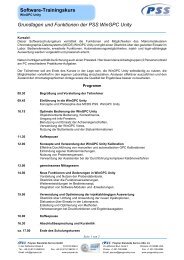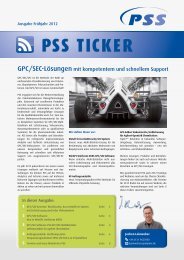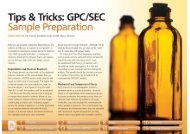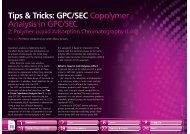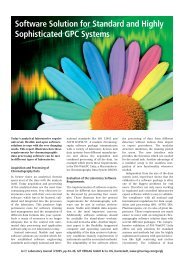PSS Streamliner 02/2008
PSS Streamliner 02/2008
PSS Streamliner 02/2008
You also want an ePaper? Increase the reach of your titles
YUMPU automatically turns print PDFs into web optimized ePapers that Google loves.
Autumn <strong>2008</strong> A Joint publication of <strong>PSS</strong> GmbH, Germany and <strong>PSS</strong> USAGPC <strong>Streamliner</strong>Focus: Innovative leadershipIntegrated, Powerful,yet Inexpensive: TheGPC/SEC Compact1120GPC/SEC systems are offered by many companies;however, <strong>PSS</strong> is the only one company worldwide concentratingexclusively on all aspects of GPC/SEC innovationsand development. <strong>PSS</strong> influence and leadershipis noted by customers, cooperation partners andeven followed by competitors. <strong>PSS</strong> was the first toidentify the need for separation phases that wouldyield interaction free GPC/SEC in polar organic eluents,and introduced the GRAM phase for GPC separationsin medium polar organic solvents. Celebrating its 10thanniversary, <strong>PSS</strong> GRAM has just recently begun to facethe competition of alternatives made available by othermanufacturers. The development of the „Magic Triangle”has also been acknowledged as state-of-theartconcept for GPC practitioners. An interview withthe head of the column development at <strong>PSS</strong>, Dr. Gün-In This Issue123456ter Reinhold, recounts <strong>PSS</strong> column philosophy anddevelopment over the last 10 years.<strong>PSS</strong> continues to seek value-added instrument options:In the previous GPC <strong>Streamliner</strong> <strong>PSS</strong> presentedthe first semi-micro GPC system and this issue presentsa new compact GPC1120 system, which enablesuniversities and institutes to acquire approved andhigh quality systems at lower prices.Summer 2009 will bring the next offering of <strong>PSS</strong> latestcourse, Viscometry and Light Scattering Hands-onTraining. This course is targeted for all users of molarmass detection, and persons, interested on the possibilitiesand limitations of these methods. The trainingincludes theory and practice.Focus: Innovative leadershipIntegrated, Powerful, yet Inexpensive:The GPC/SEC Compact 1120ReportDesigner plus – Superior FunctionalityThe <strong>PSS</strong> NetCommunity “Members Only”A success GPC column innovation story:<strong>PSS</strong> GRAM 10th Anniversary<strong>PSS</strong> Distributors<strong>PSS</strong> introduces an economical GPC/SEC system, theCompact 1120 System which has Agilent components,well known for their outstanding performance,unrivaled quality, robustness and readily availablespare parts. Like with the modular <strong>PSS</strong> SECcurityGPC/SEC system that many users already know andtreasure, <strong>PSS</strong> adds value to the Agilent technologythrough GPC software, advanced detection, reliablecolumn technology and expert support.The GPC/SEC Compact 1120 System is a breeze tosetup and handles all analytical GPC/SEC tasks. It isfocused on fundamentals, very easy to use, and hassuperior precision and reliability even in harsh environments.All its characteristics make it the perfectaffordable solution for teaching at universities, collegesand production sites where modular systems leadto unwanted user interaction.<strong>PSS</strong> offers the GPC/SEC Compact 1120 System in 3basic configurations which are fully equipped, but canbe easily upgraded any time for additional tasks.» Continues on Page 2Viscometry and light scatteringHands-on TrainingCourse for successful workwith molar mass sensitivedetectors:Mainz/Germany, June 29 – 30, 2009• Introduction to advancedpolymer analysis• Molar mass and sizedeterminationMore information at www.polymer.de orvia email info@polymer.de1
ReportDesigner plus –Superior FunctionalityThe ReportDesigner plus allows its users to design andproduce custom report layouts efficiently and effectivelythanks to extra functionality added to the originalWinGPC Unity ReportDesigner module. The earlymodule enabled users to add, remove, and combineresults and information, plus perform further evaluationsand calculations, above and beyond the standardWinGPC Unity report layouts. The latest ReportDesignerplus excels with the following:Multi-page capability: The central layout-element ofthe ReportDesigner plus is the Report Container, whereyou can arrange the position of all report elements.Reports may continue on following page(s) withoutany problem. You can define if objects should appearon every page (e.g. the company logo), only the firstor last page (e.g the summary), or on following pagesby assigning them to the respective Layer. Furthermore,you can select the page format for subsequentpage(s), if a different orientation is required (e.g. portraitfor the first page, landscape for the secondpage).Simplified statistical evaluation: Average valuesand standard deviations can be easily calculatedusing the statistical functions ‘Avg’ And ‘StdDeviation’.New chart objects (e.g. 3D-bar and 2D-piecharts) and crosstabs depict statistical evaluations. Inaddition, you can easily sort table entries by numbersor alphabetical and display them well arranged with“Zebra pattern“.Accurate Documentation: Actual measurementconditions are documented using the ReportDesignerplus in connection with the WinGPC Unity System-Pilot (software module to control SECcurity, EcoSECand Agilent 1100/1200/1120 GPC systems). At injecttime, pump pressure, oven temperature, UV wavelengthetc. are saved with the data. Device names,serial numbers and firmware versions of connectedmodules are recorded automatically, too. This informationcan be printed on the report.Users of the WinGPC Unity Compliance Pack can printout all audit trails (session, sample, instrument anduser administration).Additionally, search results and parameters are availablefor the ReportDesigner plus and can be embeddedinto statistical reports. The sample sequence list canbe reported as well.Versatile export media: The ReportDesigner plus offersthe ability to print directly as PDF-documents withoutthe need to install an additional PDF-printer. In addition,you can export Excel- or HTML-format as well asall common graphic and text formats. The defaultexport medium (printer, preview, file, Adobe pdf orothers) is saved with the layout for automatic reporting.If required, it can be easily changed with oneclick before manual printing.Friendly use: When you create a new layout, you areassisted by a software wizard. Also the user interfacehas been structured and optimized for usability. Forinstance, you can select all layout elements from theobject list or the report structure. Double clicking onthe element opens the related properties dialog withall available options. Numbers can be easily formattedusing a convenient dialog where e.g. the numberof decimal places can be selected. New variables ase.g. Detector_1_Signaltype or Overlay.Curve_01.displayfacilitates conditional displaying of data, tableentries and figures and help to create general layoutsthat work for all system configurations.The function ‘AskStringChoice$’ may be used torequest user inputs while printing. The user choosesthe text message from a predefined list to save timeand minimize incorrect entries.Prepare visually convincing customized reports; usethe WinGPC Unity ReportDesigner plusInnovationsExpanded production capacityfor specialty polymers<strong>PSS</strong> has now expanded its production capacity in thearea of specialty polymers and is now able to performsynthesis of large amounts promptly and competently.<strong>PSS</strong> has been known for many years for the synthesisof tailor made polymers; we use modern polymerizationmethods to synthesize molecules with target molarmass, composition or architecture according customerdemand.<strong>PSS</strong> proficiency includes the following polymerizationmethods:• Radical polymerization• Emulsion and suspension polymerization• Anionic polymerization• Cationic polymerization• Controlled/living radical polymerizationControlled radical polymerization techniques such asAtom Transfer Radical Polymerization (ATRP), ReversibleAddition Fragmentation Chain Transfer (RAFT) andNitroxide Mediated Radical Polymerization (NMP) enable<strong>PSS</strong> to directly polymerize a number of (co)monomerslike (meth-)acrylate, (meth-)acrylamide, styrene,isobutylene, vinylpyridine and (meth-)acrylic acid.Viscometry and Light ScatteringHands-on Training<strong>PSS</strong> added a course to their training portfolio in Mainz,June 29-30, <strong>2008</strong> offering the Viscometry and LightScattering hands-on training.The new curriculum covers all aspects of advanceddetection methods and instrumentation, used for thedetermination of molar masses, sizes, and structuresof soluble macromolecules and biopolymers. Lecturesthat provide the theoretical background are complementedwith hands-on training on experimentalaspects and data processing regarding (multi angle)light scattering and viscometry techniques. Smallworkgroupdiscussions with an experienced polymerchemist and a trouble-shooting session ensure that allaspects of molar mass sensitive detection are efficientlycovered, including specific applications andquestions.Report of the sample statisticAuthor:Dr. Jürgen PaulsdorfTel.: +49-6131-96239-44E-Mail: JPaulsdorf@polymer.deEmail info@polymer.de formore information. Find theprogram and registrationform at www.polymer.de3
The <strong>PSS</strong> NetCommunity“Members Only”Upcoming eventsGPC/SEC training course,Mainz, GermanyThe <strong>PSS</strong> NetCommunity is a free of charge on-lineinformation service for all registered customers andvisitors of our website www.polymer.de and is integralto the <strong>PSS</strong> communication strategy.NetCommunity members have access to functionalityand content not available to unregistered visitors, e.g.:• Every detail and relevant condition for columnapplications like sample preparation, solvent,column material, sample concentration and recommendationsfor calibration• Enhanced WinGPC support with access to on-linetools like the NetViewer• All WinGPC Newsletter documents in the [InfoCenter]section with comprehensive application notesand software tips&tricks• All <strong>PSS</strong> communications in pdf format to download,save and print e.g. <strong>PSS</strong> lectures, documentation ornotes that are restricted from the public at largeFig. 2<strong>PSS</strong> customer information and documents are managedin several databases. Our website offers a simultaneoussearch and comprehensive return of resultsfrom all our databases: <strong>PSS</strong> product database, thecolumn application database and the publication data-Fig. 1base. After entering one or more keywords in the section[Products] a [Site Search for Products, Applications,and Publications] starts.The example below shows how this works(comp. Fig. 2):A search for "membrane" yields 3 hits in the productdatabase (not shown) and 8 hits in the publicationdatabase. While everyone can view and download the<strong>PSS</strong> <strong>Streamliner</strong> newsletters (English) and Ticker (German),other documents with detailed description ofmembrane characterization procedures in WinGPCUnity, are only visible to logged in visitors. A message“Publication is locked” and a padlock symbol appearinstead. The information becomes visible and may bedownloaded as soon as the visitor logs in (see Fig. 1).Registration is required to enjoy the advantages of theNetCommunity. Go to the website [NetCommunity][Registration] section (see Fig. 1). Enter a user name,password, and some personal information (see Imprint& Privacy Policy). Your account is established andaccessible right away.<strong>PSS</strong> will update the NetCommunity over time withitems like WinGPC updates, general user documentationand support documents. <strong>PSS</strong> will automaticallyinform all Netcommunity members when new servicesare available.Author:Dr. Daniela HeldTel.: +49-6131-96239-41E-Mail: DHeld@polymer.deMarch 19–20, 2009Come to Mainz, Germany to obtain the skills formodern analysis of macromolecules molar mass andproperty distributions, using gel permeation chromatography(GPC), a.k.a. size exclusion chromatography(SEC). The theoretical lectures and practical sessionsprovide the fundamental aspects of the GPC/SECseparation technique, with a balanced view of both,the advantages and limitations of GPC/SEC (standaloneor hyphenated with light scattering, viscometry,and other techniques). The small group practicalsessions (5:1 student-instructor ratio), provide youwith choices between aqueous or organic solventsand/or beginner vs. advanced user.Hands-on training course:Viscometry and Light Scattering,Mainz, GermanyJune 29-30, 2009See page 3 ”Innovation”Shows and ExhibitsJanuary 28-30, 2009SCM-4 in Amsterdam, The NetherlandsTalk: Dr. Martina Adler „Supreme Resolution inGPC/SEC utilizing a novel micro GPC/SEC systemPlease visit our boothMay 11-15, 2009Achema 2009 in Frankfurt/GermanyPlease visit our boothJune 7-9, 2009Frontiers in Polymer Science in Mainz/GermanyPublisher:<strong>PSS</strong> Polymer Standards Service GmbHPostfach 3368 • D-55<strong>02</strong>3 Mainz • GermanyTel.: +49 (0)6131-96239-0Fax: +49 (0)6131-96239-11E-Mail: info@polymer.deWeb: www.polymer.de<strong>PSS</strong> Polymer Standards Service-USA, Inc43 Jefferson Blvd. Ste 3Warwick, RI <strong>02</strong>888 • USATel.: +1-401-780-8884Fax: +1-401-780-8824E-Mail: pssusa@polymer.deWeb: www. pssgpcshop.comLayout and Graphics:odd gmbh grafische betriebe • www.odd.de4
A success GPC column innovation story:<strong>PSS</strong> GRAM 10th AnniversaryInterview with Dr. Günter Reinhold, head ofthe <strong>PSS</strong> column development departmentIn 1998 <strong>PSS</strong> broke new ground into the development ofspecialized stationary phases, with a material especiallydesigned for the analysis of polar polymers in eluentslike DMF, DMAc, NMP or DMSO. Today, <strong>PSS</strong> innovativeGRAM columns have become the industrial standard forthe analysis of polyurethanes, polyimides, starches, celluloses,certain polyamides and other polar polymers;meanwhile other column producers have followed the<strong>PSS</strong> concept and also have started to offer dedicatedcolumns. <strong>PSS</strong>’ concept of polarity-balanced systems,easily visualized with the <strong>PSS</strong> magic triangle, has becomean imperative for synthesis of better separationmaterials.Dr. Reinhold, what prompted the development of theinnovative GRAM material?10 years ago only two types of GPC/SEC separationphases were available: polar phases for analysis inaqueous solutions and non-polar phases (styrenedivinylbenzene SDV) for GPC analysis in organic eluents.Consequently, all polymers soluble in organicmedia were characterized on SDV phases, regardlessof their ability to yield interaction free separation. Forexample, measurements in DMF, DMAc or DMSO wereinevitably carried out in SDV, a system that was notpolarity-balanced, creating suboptimal analytical conditionsand questionable results; one clear illustrationcould be low molar mass polystyrenes which eluteafter the system peak, thus indicating interaction withthe column.We set out to design a new material suitable for mediumpolar organic solvents that produce credible characterizationresults from true GPC/SEC separation.GRAM was the first material worldwide produced specificallyfor GPC/SEC in medium polar solvents andsuccessfully tested in the field. By the way, the theoreticalbackground for this development relied upon themagic triangle concept of polarity balance; and thebetter we understood this concept, the strongly werealized that three phases would not be enough for thewide range of polymeric materials that have evolvedover the last years. Therefore the development processcontinues.What main features does <strong>PSS</strong> aim to achieve whendesigning new column materials?The most important feature is that the new materialenables interaction free chromatography for a varietyof polymers. However, this is only one aspect. In orderto be valuable in laboratories we look for well definedmaterials, the columns must be robust and presentstability toward temperature and long term use. Thereforethe material synthesis and the column productionrequire high reproducibility. Low batch reproducibilityis a knock-out criterion, even for the most promisingmaterial. <strong>PSS</strong> column customers can rely on the fact,that once an application on a column has been established,the column will always be produced in thesame way. This guarantees that obtained results arecomparable with all previous results, and ensures longterm traceability. Finally, it must be possible to producedifferent porosities to cover a wide molar mass rangethrough mismatch-free columns of single porosity orlinear (mixed bed).What can <strong>PSS</strong> customers expect from their <strong>PSS</strong>columns?Consistent high quality; the <strong>PSS</strong> separation materialsynthesis and column production is regulated by thestrict standards of our quality management systemaccording to DIN ISO 9001:2000.100% quality control; every single GPC/SEC column istested and comes with its dedicated quality certificate.Often, vials containing test substances are shippedwith the columns, for the client to test the received andfreshly installed column(s) in his lab using the sameconditions and substances <strong>PSS</strong> used. As a specialcustomer service <strong>PSS</strong> delivers the columns in the eluentof choice, to obviate costly and time-consumingeluent change procedures in the lab. Preconfiguredcolumn connectors are also shipped with the columnsfor quick and easy installation.The <strong>PSS</strong> column combinations and materials for thesingle porosity and linear columns are carefully selectedso that the pores are ideally matching. This avoidscolumn mismatch and measuring artifacts.Support; <strong>PSS</strong> column clients have access to competentsupport via phone or e-mail by experienced polymerchemists, who are in direct contact with the developmentdepartment and help find solutions for novelapplications.What can <strong>PSS</strong> column clients expect in the next years?<strong>PSS</strong>’ main business is GPC/SEC. This is where wehave our core competence. As highly educated polymerchemists we will concentrate on ideal solutionsfor our clients. The design and the development of newmaterials is an ongoing process. We will respond tothe demand for new GPC/SEC phases which weexpect will increase as new macromolecules are discovered.The experience gained from developingGRAM from scratch is the foundation stone and a headstart for the synthesis of new and better materials; theongoing requests to find answers to customer- specificseparation problems are a motivation to continueour successful development work.Author:Dr. Günter ReinholdTel.: +49-6131-96239-90E-Mail: GReinhold@polymer.deApplicationCharacterization of Hydroxyethylstarch (HES)Hydroxyethyl starch (HES) is extracted from potato orcorn starch; HES major component (close to 100%) isamylopectin, which has been partly hydroxyl-ethylatedto prevent degradation. Various degrees of hydrolysis,also called degree of substitution, make HES a heterogeneouspolysaccharide unlike pullulan (homogeneouspolysaccharide). Today, large HES molecules are available:first generation about 400 000 Da, second generationabout 200 000 Da, and third generation about130 000 Da., corresponding to degrees of substitutionfrom 0.7 to 0.4Sample preparation:The sample is dissolved in water. The dissolution timedepending on the molar mass is between 6 and 24hours.Analytical conditions:Eluent: Water + 0,05w% NaN 3Columns: <strong>PSS</strong> SUPREMA Lux 10 µm3000Å (8 x 300 mm)+ precolumnCalibration standards: Pullulan/DextranData acquisition: <strong>PSS</strong> WinGPC UnityDetectors: SECcurity GPC1200 RI,MALLS SLD7000Flow rate: 1.0 ml/minConcentration: 3 g/lInjection volume: 100 µlConcentration [g/l]0.110.100.090.080.070.060.050.040.030.<strong>02</strong>0.01Molar mass [Da]Fig.1: Overlay of three Hydroxyethyl starches,red: Mw = 1500K Da; PDI = 1.15; z 1/2 =16nm; green: Mw = 140K Da; PDI = 1.05;z 1/2 = 8nm; blue: Mw = 160K Da; PDI = 2.5;= 12nm.z 1/210 7 10 610 510 410 310 221 2 23 24 25 26 27 28 29 30Elution volume [ml]Results and conclusion:Differences in HES lots can effortlessly detected andquantified by GPC/SEC, measuring their molar massagainst Dextran and/or Pullulan calibration standards.For a simultaneous determination of molarmass and structure information GPC-MALLS couplingis recommended. This method allows a fast andcomprehensive characterization (see fig. 1). Informationabout molar mass and radius of gyration allowsconclusions on the structure, degree of substitutionand the branching. Exact results require the dn/dcvalue of the sample.<strong>PSS</strong> WinGPC Unity, Build 6082, LAB_PROD1, Instanz #15
<strong>PSS</strong> DistributorsAustriaCP-Analytica GmbHAm Pulverturm 172130 Mistelbachphone : +43-(0)2572-4381fax : +43-(0)2572-20791email : info@cp-analytica.atWeb : www.cp-analytica.atcontact : Josef MassongGreeceAnalytical Instruments S. A.9 Tzavella str.152 31 Chalandriphone : +30-(0)210-674 89 73fax : +30-(0)210-674 89 78email : contact@analytical.grWeb : www.analytical.grcontact : Katerina AravantinouKoreaDong-il Shimadzu CorpD.I Bldg. 3F 90-1 NonHyun-Dong 135-818kang nam-Ku - SEOULphone: +82-2-5405541fax: +82-2-5412163email: wypyo@e-shimadzu.co.krWeb : www.e-shimadzu.co.krcontact: Pyo Woo Young or Yun Kyung KimSpainIngenieria Analitica S.L.Avda. Cerdanyola 73, 3° Ida08190 Sant Cugat del Vallès, Barcelonaphone: +34-90-2456677fax: +34-90-2466677email: inf@ingenieria-analitica.comWeb : www.ingenieria-analitica.comcontact: Pau CastellsBeneluxDa Vinci Europe Laboratory Solutions B.V.Cairostraat 103047 BC Rotterdamphone: +31-(0)10-2581870fax: +31-(0) 10-2581879email: cees.oudijn@davincieurope.comWeb : www.davincieurope.comcontact : Cees OudijnChinaChance International Group Ltd.Rm. 1903, Yimao Building,No. 1399, Jinqiao Road200129 Shanghaiphone: +86-(0)20-50550642fax: +86-(0)20-50310742email: info@chanceint.comWeb : www.chanceint.comcontact: Candy NiCzech RepublicScitech spol. s.r.o.Nad _árkou 75160 00 Praha 6phone : +420-(0)2-24311850fax : +420-(0)2-24311850email : scitech@scitech.czWeb : www.scitech.czcontact : Dr. Pavel Dra_arDenmarkPOLYGEN ApSKloeftevaenget 4, Postboks 4668700 Horsensphone: +45-(0)70-101088fax: +45-(0)70-221088email: tv(at)polygen.dkwww: www.polygen.eucontact : Torben VindFranceBlossom Products5/7, place Marcel RebuffatVillejust91971 Courtaboeuf Cedex frphone: +(33) (0)1-60-10-37-74fax: +(33) (0)1-60-14-07-94email: jpg@blossom-partners.frWeb: www.blossom-products.comcontact: Jean-Pierre GrenottonIndiaChromline Equipment (I) Pvt. Ltd.152-D, 1st floor, Udyog Bhavan,Sonavala Road, Goregaon (East)Mumbai - 400 063phone: +91-(0)22-26860816fax: +91-(0)22-26860306email: chromline_india@vsnl.comWeb: www.chromlineindia.comcontact: Rajendra BarabdeIrelandBrennan & Company61Birch AvenueStillorgan Industrial ParkStillorgan, Co. Dublinphone: +353-(0)1-295 2501fax: +353-(0)1-295 2333email: enquiries@brennanco.ieWeb : www.brennanco.iecontact: Mogan BurgessIsraelBargal Analytical Instruments & SoftwareLtd.Galil StreetAirport City 69719phone: +972-(0)3-9796533fax: +972-(0)3-9796538email: bargal@bargal.co.ilWeb : www.bargal.co.ilcontact: Dr. Arie GillonItalySRA Instruments Italia S.r.l.Viale Assunta 10120063 Cernusco sul Naviglio (Mi) itphone: +39-<strong>02</strong>-92143258fax: +39-<strong>02</strong>-92470901email: miliazza@srainstruments.comWeb : www.srainstruments.comcontact: Armando MiliazzaJapanS.A.S. Corporation3-16-4 Kinugaoka, Hachioji192 Tokyophone: +81-426-465662fax: +81-426-465692email: sas@fa2.so-net.ne.jpWeb : www.sascorp.jpcontact: Otohiko SatoNorwayInstrument Teknikk A.S.Østensjøveien 360667 Oslophone : +47-(0)-23 19 46 40fax : +47-(0)67-23 19 46 41email : it@instrument-teknikk.noWeb : www.instrument-teknikk.nocontact : Bosse EmilssonPolandAnchem Sp z.o.o.ul. Rakowiecka 36<strong>02</strong>-532 Warszawaphone: +48-(0)22-6462660fax: +48-(0)22-6462685email: info@anchem.plWeb: www.anchem.plcontact: Mariusz MalczewskiPortugalElnor Equipamentos Tecnicos e de LaboratorioSAR. Frei Jeronimo Brito Melo, 8354465-642 Leca do Baliophone: +351-(0)22-9050400fax: +351-(0)22-9050499email: info@elnor.comWeb : www.elnor.ptcontact: Adâo AraújoSlovakiaScitech spol. s.r.o.Nad _árkou 75160 00 Praha 6phone : +420-(0)2-24311850fax : +420-(0)2-24311850email : scitech@scitech.czWeb : www.scitech.czcontact : Dr. Pavel Dra_arSloveniaKobis d.o.o.Kidri_eva 111236 Trzinphone: +386-(0)1-5636080fax: +386-(0)1-5636089email: info@kobis.siWeb : www.kobis.sicontact: Marko PrezeljSwedenDalco ChromTech ABTingsvägen 19191 61 Sollentunaphone: +46-(0)8-59496969fax: +46-(0)8-59496968email: info@dalcochromtech.seWeb : www.dalcochromtech.secontact: Johan StormlundTurkeyAnt Teknik Cihazlar Paz.ve Dis Tic. LtdBurhaniye Mah. Beybostani Sok. No: 37/134676 Beylerbeyi/Istanbulphone: +90 216 422 67 00fax: +90 216 422 39 54email: antteknik@antteknik.comWeb : www.antteknik.comcontact: Ali Kemal KarakUnited KingdomKromatek Ltd.18 Oak Industrial Park Chelmsford RoadGreat Dunmow, CM6 1XN gbphone: +44-(0)1371-876500fax: +44-(0)1371-873237email: inbox@kromatek.co.ukWeb : www.kromatek.co.ukcontact: Nigel Hopkinson6



